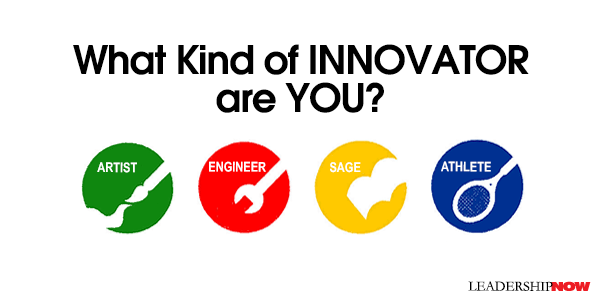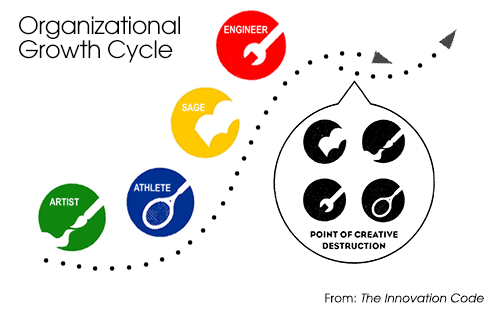 |
 |
08.09.17

What Kind of Innovator Are You?
I When it comes to innovation, it is no different. Jeff DeGraff writes in The Innovation Code, “Your dominant worldview is your biggest strength—the quality that makes you stand out from other people.” He adds, “On the other hand, your dominant worldview is holding you back. Your defining quality is also your greatest weakness. The problem is that our dominant worldviews overpower all other points of view.” And it distorts reality as we miss the bigger picture. So the place we want to come to is knowing what gift or perspective we bring to the table and then learn to combine it with the gifts of others to create a positive tension that promotes sustainable and scalable growth. First, we need to get to know ourselves. DeGraff describes four basic worldviews or approaches to innovation: the Artist, the Engineer, the Athlete, and the Sage. The Artist The Engineer The Athlete The Sage DeGraff provides each type with more in depth characteristics and examples. He lays out the strengths and weaknesses of each and what do about it, including how to work with each of the other types. What kind of innovator are you? DeGraff has created an online assessment. Here’s the thing. When you bring these four types together it can get messy. But it can be constructive. “The key,” says DeGraff, “is not to strike a balance but to know when you need more or less of each approach.” If we know the strengths and weaknesses of our type, then we can know what types we need to surround ourselves with to complete the picture and to find an approach that will work. Knowing the kinds of innovators you need to bring to a project is all about knowing all of those things you can’t do (well) yourself. Not surprisingly, different stages of organizational growth require more of one type over another. “At their onset, groups need more Artists and Athletes. Artists will give a young company a creative edge, while Athletes come up with a playbook. As it starts to grow, the organization has to get the right people and community involved and develop the best customer relationships. This is when the company needs Sages. Finally, when the organization gets really big, it needs structure, processes, and hierarchy—the gifts of Engineers.” When it matures, the organization needs to reinvent itself. “Instead of maintaining the same ratio of different kinds of thinkers, the organization needs to incorporate more Artists or Athletes or Sages or Engineers, whichever form will add more variance to the current situation.”  “When you combine the radical, visionary thinking of the Artist and the methodical, practical thinking of the Engineer, you get innovation that’s both revolutionary and manageable, highly ambitious but without high risk. When you combine the cutthroat, results-oriented attitude of the Athlete with the conscientious, values-oriented attitude of the Sage, you get innovation that’s both a good investment and good for the world.” 
Posted by Michael McKinney at 12:18 AM
|
BUILD YOUR KNOWLEDGE
 

How to Do Your Start-Up Right STRAIGHT TALK FOR START-UPS 
Grow Your Leadership Skills NEW AND UPCOMING LEADERSHIP BOOKS 
Leadership Minute BITE-SIZE CONCEPTS YOU CAN CHEW ON 
Classic Leadership Books BOOKS TO READ BEFORE YOU LEAD |